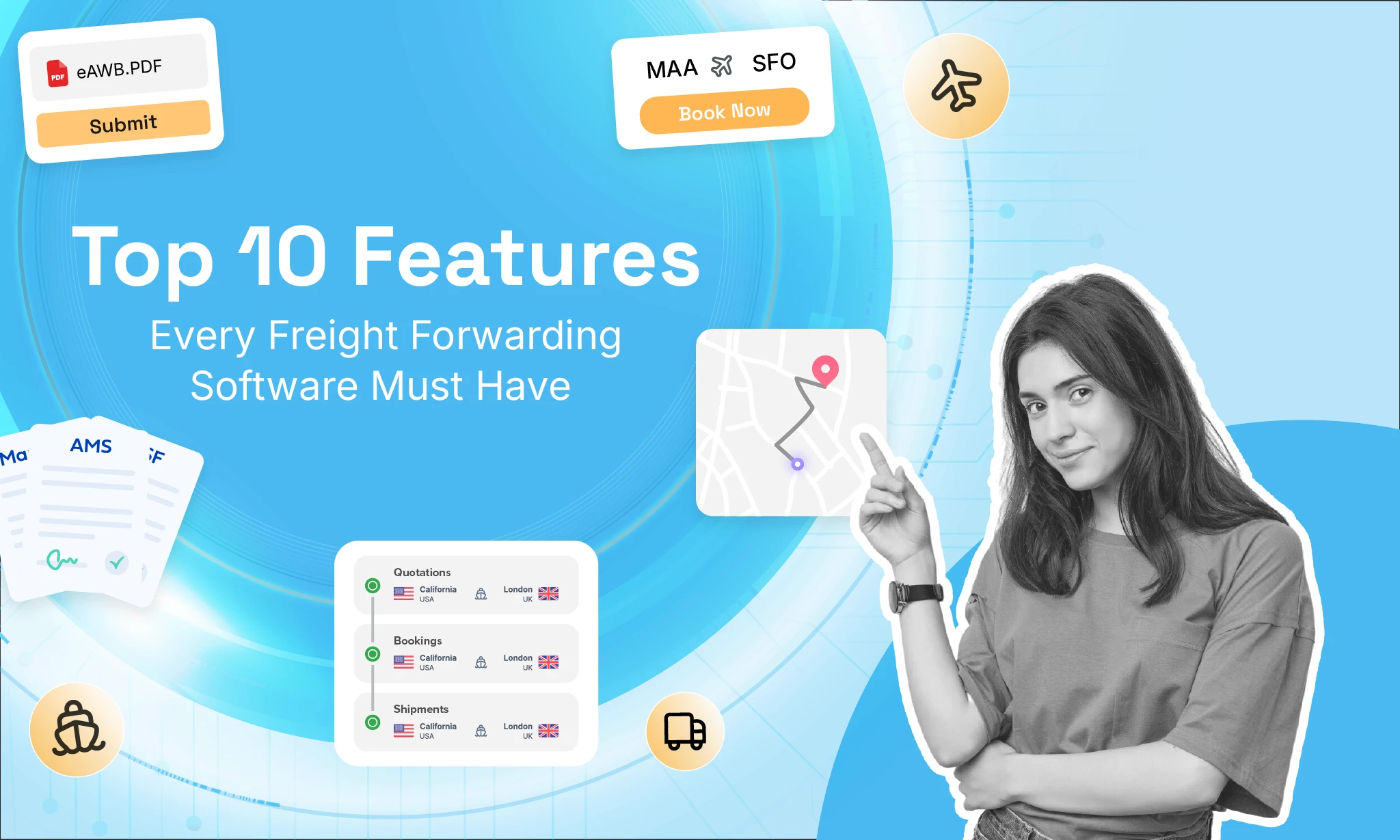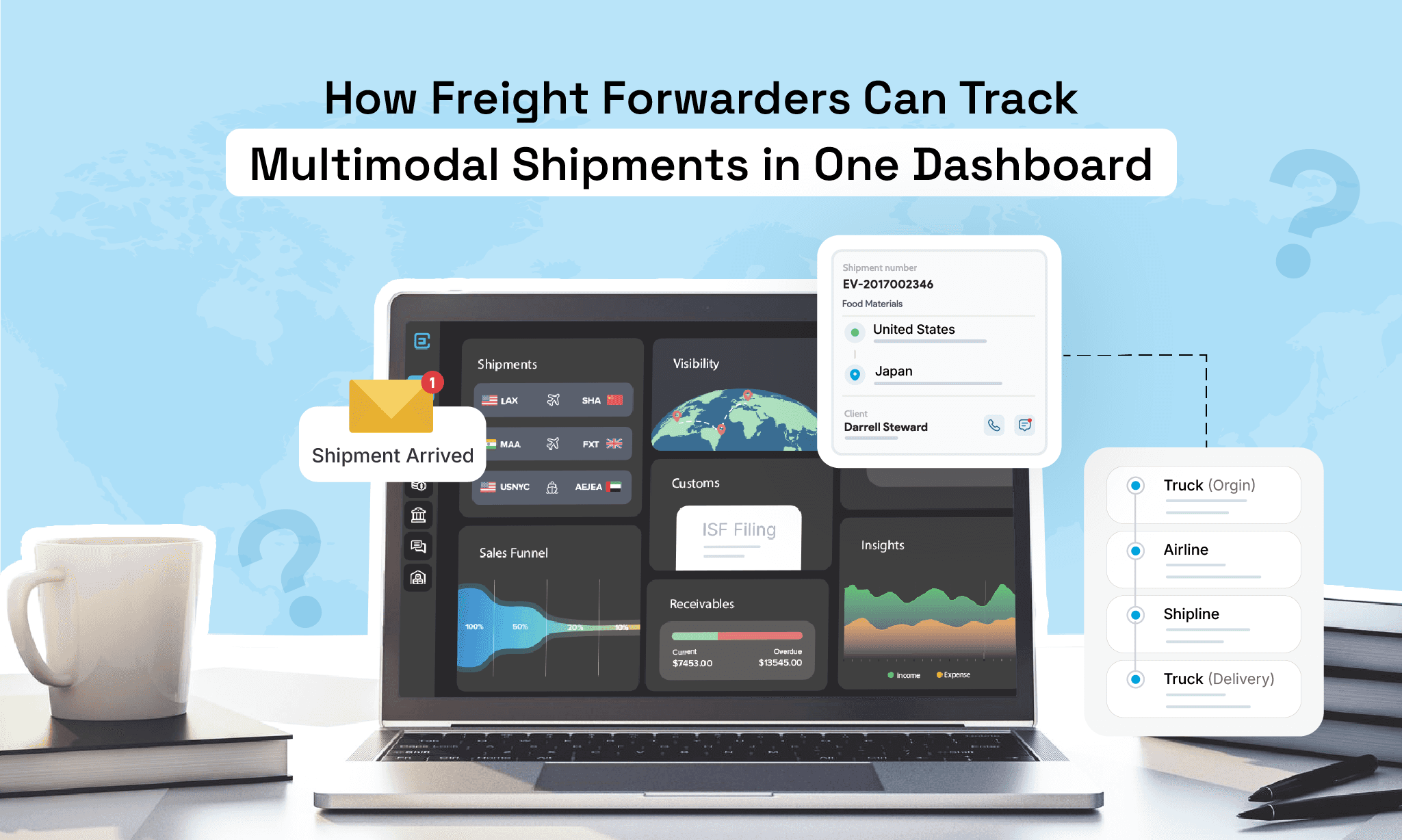Digital Transformation in Logistics: Trends for 2025-26 Unveiled
Author:
Divya Murugan
Published On:
Sep 15, 2025
Updated On:
Sep 15, 2025
1 min read
The logistics industry is experiencing a major shift as companies embrace new digital tools and smart technologies. Supply chains are no longer just about moving products from point A to point B, they have become strategic business assets that create competitive advantages. Companies are using artificial intelligence, automation, and data analytics to make their operations faster, cheaper, and more reliable.
This digital revolution is changing how goods move around the world. AI systems now make decisions without human help, choosing the best routes and managing inventory levels automatically. Companies are also building smaller warehouses closer to customers to deliver products in just a few hours instead of days.
The changes happening now will shape logistics for years to come. Businesses that adapt to these new technologies will thrive, while those that stick to old methods may struggle to compete. The next two years will be crucial as more companies invest in digital transformation to meet growing customer demands and handle global challenges.
Key Takeaways
Digital transformation is turning supply chains into strategic business advantages rather than just cost centers
AI and automation are enabling autonomous decision-making that improves speed and efficiency without human intervention
Companies must embrace new technologies now to remain competitive and meet evolving customer expectations
Key Drivers of Digital Transformation in Logistics

Three main forces are pushing the logistics industry toward digital transformation. Smart machines and AI are taking over routine tasks, connected devices are giving companies real-time data about their shipments, and blockchain technology is making supply chains more open and trustworthy.
Automation and Artificial Intelligence in Logistics
AI and automation are changing how logistics companies handle their daily work. Smart software can now predict when deliveries will arrive and find the best routes for trucks. This helps companies save money and serve customers better.
Warehouses use robots to pick items and move boxes around. These machines work faster than people and make fewer mistakes. AI systems can also predict when equipment might break down before it actually fails.
Machine learning helps companies understand shipping patterns. The software looks at past data to guess future demand. This means companies can have the right amount of products in the right places.
Automated systems handle paperwork too. They can create shipping labels, track invoices, and update inventory counts without human help. This frees up workers to focus on more important tasks.
IoT Devices and Real-Time Tracking
IoT devices are sensors that connect to the internet and share data instantly. Logistics companies put these sensors on trucks, containers, and packages to track location and condition.
Temperature sensors make sure cold items stay fresh during shipping. GPS trackers show exactly where packages are at any time. This helps companies tell customers when their orders will arrive.
Smart sensors can detect if packages get damaged or if trucks have problems. They send alerts right away so companies can fix issues quickly. This real-time data helps prevent delays and lost shipments.
IoT devices also monitor fuel use and driver behavior. Companies can see if trucks are using too much gas or taking wrong turns. This information helps them save money and improve safety.
Blockchain for Supply Chain Transparency
Blockchain creates a permanent record that no one can change or fake. Each step in the supply chain gets recorded in this digital ledger. Everyone involved can see the same information.
This technology helps prove where products come from. Companies can show customers that their items were made ethically and safely. If there's a problem with a product, blockchain makes it easy to trace back to the source.
Smart contracts on blockchain can automatically pay suppliers when deliveries are confirmed. This reduces paperwork and makes payments faster. It also cuts down on disputes between companies.
Blockchain helps fight fake products too. Each item gets a unique digital fingerprint that proves it's real. This transparency builds trust between companies and their customers.
Technology-Driven Trends for 2025-26
Advanced technologies are reshaping logistics operations through intelligent automation and data-driven decision-making. Machine learning algorithms now predict demand patterns with 35% greater accuracy, while AI systems autonomously optimize routes and manage inventory levels in real-time.
Predictive Analytics and Machine Learning
Machine learning algorithms transform how logistics providers forecast demand and manage operations. These systems analyze historical data, market trends, and external factors to predict future needs with remarkable precision.
Demand forecasting has improved dramatically. Companies using AI-driven analytics reduce inventory levels by 35% while maintaining service quality. The technology processes vast datasets to identify patterns humans might miss.
Predictive maintenance represents another breakthrough application. AI systems monitor equipment health through sensors and data analysis. This approach cuts maintenance costs by 30% and reduces downtime by 45%.
Supply chain disruptions become more manageable with predictive models. These systems alert managers to potential issues before they occur. Early warning capabilities help companies adjust operations proactively.
Agentic AI and Advanced Decision Making
Agentic AI systems make autonomous decisions without human intervention. These advanced platforms go beyond simple automation to handle complex logistics scenarios independently.
Real-time decision making speeds up operations significantly. AI agents analyze transportation routes, demand patterns, and inventory levels simultaneously. They adjust strategies instantly based on changing conditions.
Supply chain visibility improves through AI-powered monitoring systems. These platforms track shipments continuously and predict delays before they happen. Logistics providers gain unprecedented control over their operations.
Inventory Management Optimization
IoT sensors and smart systems revolutionize how companies track and manage inventory. Real-time monitoring provides accurate stock levels across multiple locations.
Radio Frequency Identification (RFID)technology replaces manual scanning processes. This automation enhances tracking accuracy and speeds processing.
Stock optimization algorithms determine ideal inventory levels for each location. These systems balance holding costs against service requirements. Companies reduce excess stock while avoiding stockouts.
Warehouse operations benefit from automated inventory tracking. IoT devices monitor product movement and condition throughout storage. This visibility helps prevent losses and improve order fulfillment.
Route Optimization and Last-Mile Delivery Innovations
Advanced routing algorithms consider multiple variables to create optimal delivery paths. These systems process traffic data, weather conditions, and delivery schedules simultaneously.
Dynamic route planning adjusts paths in real-time. AI analyzes current conditions and modifies routes to avoid delays. Fuel consumption drops significantly through these optimizations.
Last-mile delivery solutions focus on urban efficiency. Autonomous vehicles and drones handle short-distance deliveries between distribution centers and customers. These technologies reduce delivery costs and improve speed.
Delivery companies achieve substantial improvements through route optimization. Cost reductions of 15% are common among early adopters. Customer satisfaction increases due to more reliable delivery times and better tracking capabilities.
Building Resilient, Sustainable, and Transparent Supply Chains

Digital transformation enables companies to create supply chains that adapt quickly to disruptions while maintaining environmental responsibility. Modern logistics networks integrate AI-driven analytics, transparent tracking systems, and collaborative partnerships to handle complex global challenges.
Enhancing Supply Chain Resilience
Digital tools help companies build stronger supply chains that bounce back from disruptions. AI-powered predictive analytics identify potential problems before they happen. These systems analyze weather patterns, political events, and market changes.
Companies use digital twins to test different scenarios. This technology creates virtual copies of supply networks. Managers can see how disruptions might affect operations.
IoT sensors track products in real-time throughout the supply chain. This data helps companies spot delays or quality issues quickly. When problems arise, automated systems can reroute shipments or find backup suppliers.
Blockchain technology creates transparent records of all transactions. Each step in the supply chain gets recorded permanently. This makes it easier to trace problems and verify product authenticity.
Key resilience strategies include:
Diversifying supplier networks across multiple regions
Building inventory buffers for critical components
Creating automated backup systems for key processes
Training teams to respond quickly to disruptions
Sustainable Practices and Green Logistics
Green logistics reduces environmental impact while cutting costs. Companies track carbon emissions from transportation, warehousing, and packaging. Digital platforms calculate the environmental cost of different shipping routes.
Electric vehicles and alternative fuels replace traditional diesel trucks. Route optimization software reduces miles driven and fuel consumption. Warehouse automation systems use less energy than manual processes.
Sustainable packaging uses recyclable materials and right-sized boxes. Smart packaging sensors monitor product condition during transport. This reduces waste from damaged goods.
Green supply chain metrics include:
Carbon footprint per shipment
Percentage of renewable energy used
Waste reduction achieved
Water conservation measures
Companies share sustainability data with customers and partners. Transparent reporting builds trust and meets regulatory requirements. Many businesses set science-based targets for carbon reduction.
Supply Chain Disruption Management
Modern disruption management combines technology with strategic planning. Machine learning algorithms analyze historical disruption patterns. They predict which suppliers, routes, or regions face higher risks.
Companies create multi-tier supplier visibility. This means tracking suppliers of suppliers. When a disruption hits one area, businesses can quickly find alternative sources.
Real-time communication platforms connect all supply chain partners. When disruptions occur, everyone gets updates simultaneously. This speeds up response times and reduces confusion.
Risk assessment tools evaluate supplier financial health and operational stability. Companies monitor geopolitical events that might affect trade routes. Weather tracking systems provide early warnings for natural disasters.
Disruption response plans include:
Pre-approved alternative suppliers
Emergency transportation options
Flexible contract terms
Cross-trained staff for critical functions
Strategic Partnerships in Global Trade
Strategic partnerships create stronger, more flexible supply networks. Companies work together to share resources, information, and expertise. Collaborative platforms connect multiple partners in real-time.
Technology partnerships help smaller suppliers adopt digital tools. Larger companies share software platforms and training resources. This creates more capable and reliable supplier networks.
Regional partnerships reduce dependence on single countries or suppliers. Companies build supplier relationships across different continents. This geographic diversity protects against localized disruptions.
Data sharing agreements allow partners to coordinate better. Suppliers share capacity information and production schedules. Customers provide demand forecasts and product requirements.
Partnership benefits include:
Shared risk across multiple partners
Access to new markets and technologies
Reduced costs through economies of scale
Faster innovation through collaboration
Long-term contracts provide stability for both buyers and suppliers. These agreements often include performance incentives and sustainability requirements. Regular partnership reviews ensure relationships stay productive and aligned with business goals.
Emerging Industry Challenges and Opportunities
The logistics industry faces significant workforce challenges as driver shortages intensify while geopolitical tensions reshape global supply chains. E-commerce growth continues driving demand for innovative delivery solutions, and the shift toward sustainable transportation through biofuels and electric vehicles accelerates across the sector.

Driver Shortage and Workforce Transformation
The trucking industry experiences a severe driver shortage affecting logistics providers nationwide. Current estimates show a shortage of approximately 80,000 drivers, with this number projected to reach 160,000 by 2030.
Several factors contribute to this challenge:
Aging workforce - Average driver age exceeds 47 years
Demanding work conditions - Long hours and extended time away from home
Regulatory requirements - Stricter licensing and training standards
Competition from other industries - Better work-life balance in alternative careers
Logistics companies implement various strategies to address workforce challenges. They offer signing bonuses ranging from $5,000 to $15,000 for new drivers. Enhanced benefits packages now include health insurance, retirement plans, and paid time off.
Technology provides new solutions for workforce transformation. Automated systems reduce administrative tasks for drivers. Route optimization software minimizes driving time and improves efficiency.
Geopolitical Shifts Impacting Logistics
Geopolitical tensions create significant disruptions across global supply chains. Trade policies and international relations directly affect shipping routes and logistics operations.
Current geopolitical shifts include changing relationships between major economies. China's growing influence in global markets affects trade patterns.
Logistics providers adapt by diversifying supply chain routes. They reduce dependence on single countries or regions. This strategy helps minimize risks from political instability.
Key impacts include:
Modified shipping routes to avoid conflict zones
Increased inventory buffers for critical supplies
Regional sourcing strategies to reduce international dependencies
Enhanced security measures for cargo protection
E-Commerce Logistics Growth
E-commerce continues driving unprecedented growth in logistics demand. Online retail sales force logistics providers to develop faster, more flexible delivery solutions.
Consumer expectations for rapid delivery create operational challenges. Same-day and next-day delivery options become standard requirements rather than premium services.
Last-mile delivery represents the most complex and expensive portion of e-commerce logistics. Urban areas require innovative solutions due to traffic congestion and limited parking. Rural areas face challenges with longer distances and lower delivery density.
Logistics providers invest in new fulfillment center technologies. Automated sorting systems and robotic picking solutions increase processing speed. Micro-fulfillment centers located closer to consumers reduce delivery times.
E-commerce logistics trends include:
Click-and-collect services expanding to retail partnerships
Drone delivery pilots in select markets
Crowdsourced delivery through gig economy platforms
Smart locker systems for secure package pickup
Adoption of Biofuels and Electric Vehicles
The transportation sector accelerates adoption of sustainable fuel alternatives. Biofuels and electric vehicles offer logistics providers options to reduce carbon emissions and meet environmental goals.
Electric vehicle adoption faces infrastructure challenges. Charging stations require significant investment and strategic placement along major shipping routes. Battery technology improvements extend driving range but increase vehicle costs.
Biofuels provide immediate solutions for existing diesel fleets. Renewable diesel and biodiesel blends reduce emissions without requiring new vehicles. These fuels work with current engine technology and fuel systems.
Implementation considerations include:
Technology | Benefits | Challenges |
Electric Vehicles | Zero direct emissions, lower maintenance | High upfront costs, charging infrastructure |
Biofuels | Compatible with existing fleets | Limited production capacity, cost variations |
Government incentives support sustainable vehicle adoption. Tax credits and grants help offset higher purchase prices. Emissions regulations create compliance requirements that favor cleaner technologies.
Logistics providers develop transition strategies balancing costs with environmental goals. They pilot electric vehicles on shorter routes while maintaining diesel fleets for long-haul operations.
Conclusion
The way we move goods is changing quickly. What used to be about simply getting products from point A to point B is now about speed, visibility, and resilience. AI, smart sensors, and automation are no longer just industry trends, they are the tools that keep supply chains efficient and customers satisfied.
The real challenge for businesses is deciding whether to adapt now or risk falling behind.
That is where Cargoez comes in, helping companies simplify digital transformation so they can stay ahead, deliver on time, and build supply chains that truly work for the future.
Frequently Asked Questions (FAQs)
1. What technologies are driving logistics digital transformation in 2025?
AI for real-time decision-making, blockchain for transparent tracking, IoT sensors for visibility, robotics for warehouse automation, and cloud platforms for scalable operations.
2. How is AI reshaping supply chain optimization?
AI predicts demand, adjusts routes, manages inventory, and identifies disruptions automatically reducing delays and improving efficiency.
3. What role does data analytics play in logistics?
Analytics track performance, forecast demand, spot risks early, and support greener, cost-effective transport decisions.
4. How are IoT devices improving logistics operations?
Sensors track shipments, monitor temperature, optimize routes, and predict equipment failures. Smart docks and connected warehouses boost efficiency.
5. What impact do autonomous vehicles have on logistics?
Self-driving trucks, delivery robots, drones, and warehouse forklifts reduce labor costs, extend operating hours, and improve safety.
6. What strategies help companies stay competitive?
Adopt flexible tech platforms, train staff in digital tools, focus on customer experience, use data-driven decisions, and partner with tech providers.
Don't forget to share this blog!



